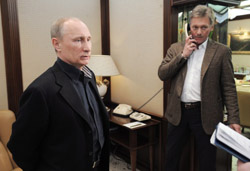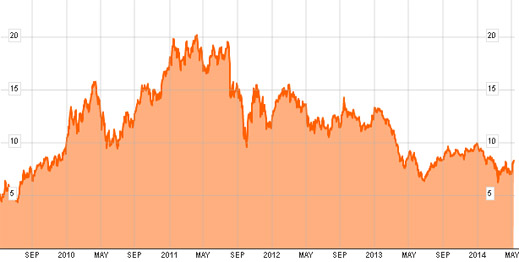
By John Helmer, Moscow
The disclosure that Severstal is planning to sell its remaining two US steelmills has taken the Russian steel industry by surprise, triggering speculation the Kremlin has asked for the move as part of the ongoing conflict between the US and Russia in Ukraine.
For the time being, Severstal’s owner and chief executive Alexei Mordashov is making no official statement. Assessments in Moscow are divided over whether Mordashov has discussed the US asset sale plan with President Vladimir Putin as part of Russia’s reaction to the threat of US sanctions against the energy and metals sectors of the Russian economy. Russian steel industry sources believe Mordashov has authorized the press leak to advertise his asset sale in an attempt to lift the price.
 There is no public record that Mordashov has met Putin in several years. Putin’s spokesman, Dmitry Peskov (right), has responded with the claim that no formal or informal recommendations have been made by the President to Russian companies to sell foreign assets in connection with the US Treasury sanctions. “No, this is out of the question. The [Severstal] company operates at its discretion.”
There is no public record that Mordashov has met Putin in several years. Putin’s spokesman, Dmitry Peskov (right), has responded with the claim that no formal or informal recommendations have been made by the President to Russian companies to sell foreign assets in connection with the US Treasury sanctions. “No, this is out of the question. The [Severstal] company operates at its discretion.”
A leading Russian industry analyst says: “it may be related to the current market situation and the possible political and economic consequences of Russia’s participation in the fate of the brotherly state. Such things are not often publicized. So let’s wait and see what would happen next. I cannot immediately confirm anything. But the feeling is there.”
The Wall Street Journal and Bloomberg have reported the Severstal asset sale as coming from “people familiar with the matter.” They claim one bidder is US Steel, which reportedly wants to buy the plant (below left) originally built by Henry Ford in Dearborn, Michigan. Brazil’s Companhia Siderurgica Nacional SA reportedly is interested in the near-new electric arc furnace mill at Columbus, Mississippi (right).

Severstal already operates with US Steel in a joint venture, Double Eagle Steel Coating Company, which produces galvanized steel for automotive production; its annual capacity is 789,000 tonnes. US Steel had been a bidder for the Rouge plant in 2003, but was out-priced at the time by Mordashov.
Then, and in his subsequent effort to buy Arcelor, Europe’s largest steelmaker in 2006, Mordashov said he wanted to become the largest steelmaker in the world. For a time he convinced Putin this was a good idea. It wasn’t – at least not for Severstal shareholders apart from Mordashov himself, whose record for self-dealing has been criticized by Russian steel analysts. In 2009 Michael Kavanagh of Uralsib Bank reported that the profits of Severstal’s Russian operations were subsidizing the debts and losses the American steel assets were running up.
That Mordashov was buying US (also Italian) steelmills as a hedge against the possibility he might lose his Russian assets explains the premium prices he paid as a form of money laundering, from which the US Treasury has benefited. That the writedowns on Severstal’s balance-sheets and loss of market capitalization have been enormous has so far not impacted on Mordashov’s oligarch status at home. Since April 2011, the collapse of Severstal’s share price has liquidated $10 billion in market value.
SEVERSTAL 5-YEAR SHARE PRICE TRAJECTORY

Source: http://www.bloomberg.com/
The latest press leaks appear to have been triggered by Severstal, which has revealed Mordashov’s asking price is $1.5 billion. One Russian source believes this to be wishful thinking on Mordashov’s part – and also his reason for the press leak. In 2009, when Severstal was struggling with the downturn in the global steel market and a debt of $7.5 billion, Mordashov proposed selling the two plants for about $1.2 billion. At the time, Nucor was reported to be negotiating, but its interest was limited to the Columbus plant. No deal eventuated for either asset. When US Steel made its offer for Rouge in 2003, it offered less cash and less investment than Mordashov.
Mordashov has subsequently sold several other US assets at a fraction of the price he paid to buy them. In 2011 he announced he had accepted $542 million in compensation from the Esmark group for the Sparrows Point, Warren and Wheeling mills for which he had paid $2.4 billion in 2008. That story can be read here. Mordashov has also been obliged to sell at a heavy loss the Lucchini assets in Italy.
There has been no hint of the selloff of Dearborn and Columbus in Severstal’s financial reports, notwithstanding a sharp contraction in Severstal’s consolidated revenues and earnings in the first quarter, and a blow-out on the bottom line — $100 million in losses for the March quarter, compared to a loss of $74 million in the December quarter.
According to Mordashov’s April 30 presentation of the quarterly results, the earnings (Ebitda) of the US steelmills had deteriorated by 18.5% to $75 million. By comparison, earnings at the Russian steel division dropped by 10% to $260 million. On the other hand, Mordashov said steel sales in the US rose 1.4% on the quarter to $1.02 billion, while in Russia sales contracted by 14.6% to $1.7 billion. He claimed that higher costs at Dearborn were caused by a severe winter leading to spikes in the prices of scrap and electricity. At Columbus, he said earnings hit a record level of $113 per tonne. By contrast with the first quarter of 2013, the earnings of the US plants had risen by 50% and the Ebitda margin was up 2 points to 7.4%. Earnings per tonne was up 40% to $63 per tonne.
In Severstal’s financial report for 2013 no assets were reported as held for sale. The report noted that in October 2013, “the credit facilities of Severstal Dearborn LLC and Severstal Columbus LLC were successfully refinanced – cost of debt was successfully decreased, financing conditions were significantly improved.” The company claims to have invested more than $3 billion in both plants since acquiring Dearborn.
Mordashov paid $285 million for the former Rouge steel assets in Michigan in 2003. The bid was approved by management and union as significantly better than an offer by US Steel. Mordashov subsequently invested about $1.4 billion in upgrading the plant. The Columbus electric arc furnace mill cost more than $1 billion to construct and was commissioned in 2007. Last year the two mills produced 4.54 million tonnes of steel, mostly hot-rolled and galvanized. US domestic sales amounted to $3.78 billion. Exports to Mexico came to $94.5 million.
The year-end report released three weeks ago claimed that in 2014 “we will be focusing on improving the quality of products at Dearborn, as well as further scrap mix optimisation and copper scheduling at Columbus, continued optimisation of logistics and revisiting our sales and marketing strategy at both assets.”
Denis Gabrielik, steel analyst at Otkritie Capital in Moscow, told clients on Monday: “On our estimates, Severstal International’s EBITDA will amount to c. $260mn in 2014. This implies that, given Severstal is asking for $1.5bn, the North American operations are valued at 5.7x EV/EBITDA, which we regard as fair (the peer average is around 6.5x). Overall, we welcome Severstal’s intention to get rid of low margin assets in the US, and see this news as slightly positive for the stock.” In the day’s trading on the London Stock Exchange, Severstal’s share price gained 3.5%. The current market capitalization is $6.89 billion.
A Sberbank report of today explains that Mordashov’s rationale for the US sale is to refill Severstal’s cash supply after the company pays bondholders to redeem its bonds. “We note that the deadline for participating in the tender offer on the Severstal 16 and 17, for which $500 mln will be spent, is today. Considering the recent redemption of the Severstal 14 Eurobond, on our estimates, the company’s cash balance will be reduced to nearly zero. Due to this, the sale of assets with the aim of replenishing the cash cushion looks entirely reasonable. On the whole, the news of the possible asset sale, particularly at a fairly hefty price, is clearly positive for Severstal’s credit quality, and this may support the company’s bond quotes.”
A US investment banker and expert on the Russian steel sector said: “I doubt at this stage that there’s a ‘sell’ order on from the Kremlin. Most likely, it is a company-initiated, Kremlin-OK’d initiative.” A European investment banker dismissed the possibility of a Kremlin order. “This is a sideshow”, he said. International sources interpret the Russian reluctance to threaten counter-sanctions against the US as a sign of Putin’s unpreparedness.
Two other Russian steelmaking groups, Evraz and Mechel, both heavily indebted, are trying to sell US assets at the moment – Evraz, its Claymont mill in Delaware, and Mechel, its coalmines in West Virginia. Pipemaker TMK, whose US and Canadian mills account for 30% of its sales, a larger proportion of its revenues than the other Russian groups in the US, said today that it has no plan to sell out of North America. Novolipetsk Metallurgical Combine (NLMK), which operates in Indiana and Pennsylvania, did not respond to questions.











Leave a Reply